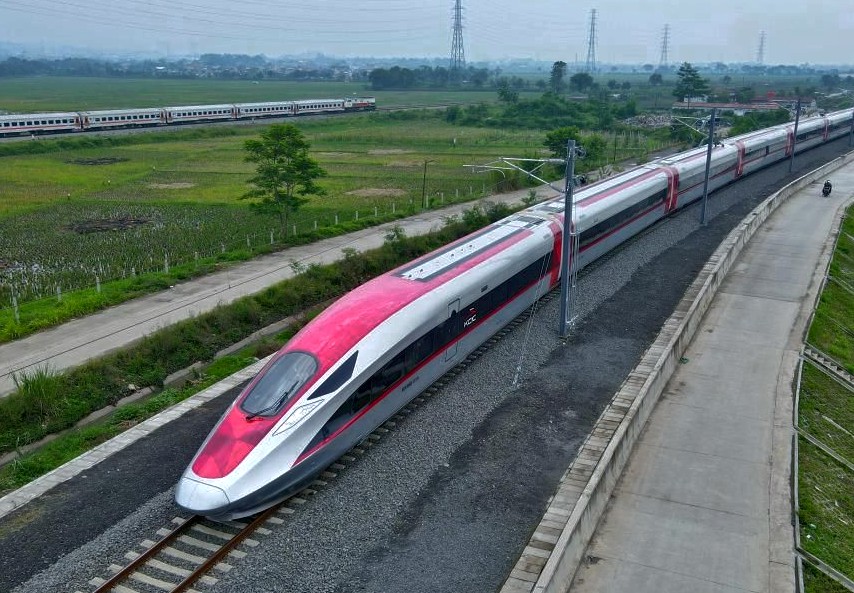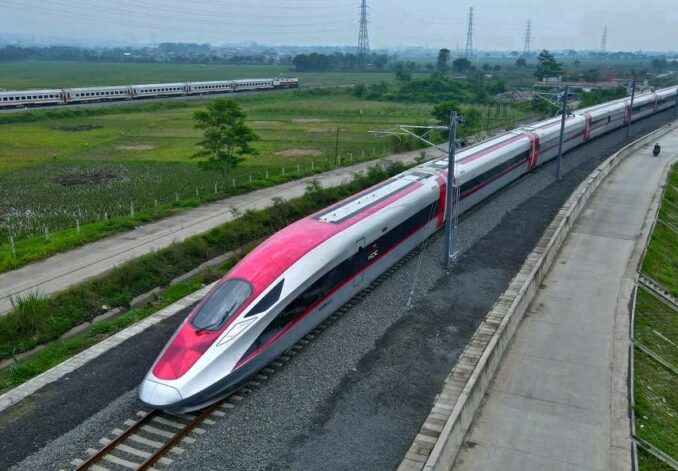

Chinese-built train for the Jakarta-Bandung high-speed line, cutting travel from 3.5 hours to 45 minutes.
By Carlos Martinez
This article was published in Global Times, Nov. 8, 2023. opinion@globaltimes.com.cn The author is a British author and independent political commentator.
The China-proposed Belt and Road Initiative (BRI) has attracted a great deal of attention recently, particularly with the Third Belt and Road Forum for International Cooperation having taken place in Beijing in October.


Chinese-built train for the Jakarta-Bandung high-speed line, cutting travel from 3.5 hours to 45 minutes.
Since it was announced a decade ago, the BRI has already become the world’s largest platform for international cooperation, with more than 150 countries and 30 international organizations participating across five continents. One trillion dollars has been spent or committed on projects that are increasingly transforming the development prospects for dozens of countries in Asia, Africa, the Caribbean, Latin America, the Middle East and the Pacific.
A number of these projects have already been delivered. The Chinese-built Mombasa-Nairobi Standard Gauge Railway, for example, is the largest infrastructure project carried out in Kenya since its independence. The China-Laos Railway, completed in 2021, has turned Laos from a landlocked country into a land-linked country, thereby stimulating trade, employment, economic opportunities and living standards. The Jakarta-Bandung High-Speed Railway –– the first high-speed rail system in Indonesia –– has reduced the journey time from 3.5 hours to 45 minutes.
The BRI is becoming green. The prominent Norwegian environmentalist Erik Solheim, former minister of the environment, stated at a webinar hosted by Friends of Socialist China on Nov. 4 that the BRI has become the most important global project in terms of green, sustainable development.
Does the U.S. –– with the world’s largest economy in nominal GDP terms –– have an equivalent to the China-proposed BRI? A few such projects have been announced, to much fanfare.
The Build Back Better World (B3W) was unveiled in 2021. The India-Middle East-Europe Economic Corridor (IMEC) was announced in September this year. But these initiatives are yet to experience any manifestation in reality –– and it’s tempting to wonder if they ever will.
BRI initiatives: global cooperation vs. war
But if we look at the actual history and reality of U.S. foreign policy, it becomes clear that the U.S. does actually have its own BRI: the Bomb and Ruin Initiative.
The Bomb and Ruin Initiative started in earnest in 1950 with the launch of the Korean War, in which an estimated 4 million people were killed. The initiative continued with the Vietnam War, the brutal 1965 coup in Indonesia, the coups and proxy wars in Angola, Argentina, Brazil, Chile, Grenada, Guatemala, Mozambique and Nicaragua, just to name a few.
The flagship Bomb and Ruin Initiative project this century so far has been the illegal war on Iraq. Hundreds of thousands of civilians were killed. The country was flattened and its development set back by decades.
China has taken a significantly different approach with respect to Iraq. Indeed, Iraq is one of the major recipients of infrastructure investment under the BRI, with a vast array of bridges, roads and railways being constructed, alongside energy and telecommunications infrastructure. China is committed to building some 7,000 schools in Iraq.
Iraq of course is best known for its abundance of oil –– certainly that has been a central motivating factor for a century of British and American interference –– but these days China is leading the investment in Iraq’s growing solar energy industry. The world can look forward to the day when Iraq is an advanced, prosperous country and a green energy superpower.
U.S. bombs, China builds
In Iraq, the contrast between the BRI and the Bomb and Ruin Initiative is quite stark. So much so that there’s a popular saying: “America bombs, China builds.”
This contrast is emblematic of the U.S.’s and China’s role in the world in general.
The U.S. has brought misery and destruction to Afghanistan, that long-suffering country, with a 20-year war and occupation, and now cruel sanctions put in place to prevent the country from getting back on its feet.
The U.S. and its allies bombed Libya into the Stone Age, turning it from a relatively prosperous country –– with the highest Human Development Index in Africa –– into a failed state.
The U.S. has been a key player in fomenting and perpetuating the devastating war in Syria, supporting the emergence of terrorist groups in a strategy of regime change, and then using the presence of those same groups as a justification for its own uninvited and unwanted military presence in the country.
About two weeks ago, the U.S. responded to attacks on its illegal Syrian facilities – not by dismantling the facilities – but by carrying out air strikes against Syrian government sites.
It’s no secret that the U.S. is the driving force behind the war in Ukraine. The essential character of this conflict is a proxy war to weaken Russia.
U.S.-backed Israel creates ‘children’s graveyard’
With the sponsorship and total support of the U.S., Israel is showing no regard at all for the people of Gaza. Already more than 10,000 people have been killed. The U.N. has called it a “children’s graveyard.” The people of the world want a ceasefire; China, Russia, Brazil and many others have called for a cease-fire. But the U.S. –– along with its most dependable ally, Britain –– is standing in the way.
The U.S. gets criticized for not building enough infrastructure. However, the U.S. is building plenty of infrastructure of war and aggression: 800 overseas military bases; the stationing of nuclear-enabled missiles and warplanes in Japan, Guam and South Korea, along with tens of thousands of U.S. troops; the placement of the THAAD so-called missile defense system in Guam and South Korea; and the AUKUS trilateral nuclear pact between the U.S., Britain and Australia. When it comes to the project of containing and encircling China, the U.S. has no problem with building infrastructure.
The stark difference between China’s BRI and the U.S.’s BRI is clear for all to see.
The U.S. is pursuing a hegemonic, imperialist project: a Project for a New American Century. It is spreading death and destruction in pursuit of its own selfish economic and political interests.
Meanwhile, China is pursuing what it calls a global community of shared future –– described by President Xi Jinping as “an open, inclusive, clean and beautiful world that enjoys lasting peace, universal security and common prosperity, charting a bright future for human development.”
This is an inspiring, democratic and inclusive vision that is rapidly gaining broad support around the globe.
As we observe the ongoing negotiations between the United States and Iran, we, the undersigned,…
Hamas issued the following statement on April 24, 2025, published on Resistance News Network. The…
By D. Musa Springer This statement is from Hood Communist editor and organizer D. Musa…
Portland, Oregon On April 12 — following protests in Seattle and elsewhere in support of…
This statement was recently issued by over 30 groups. On Friday, March 28, Dr. Helyeh…
When Donald Trump announced massive tariffs on foreign imports April 2, Wall Street investors saw…